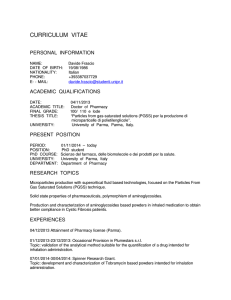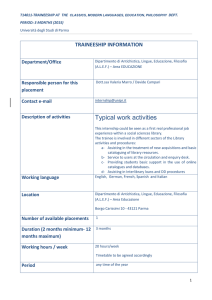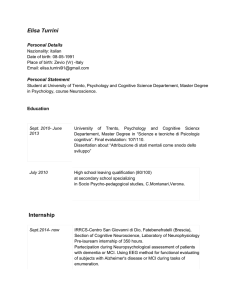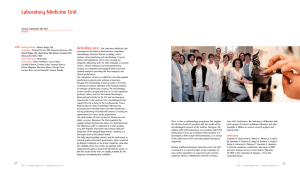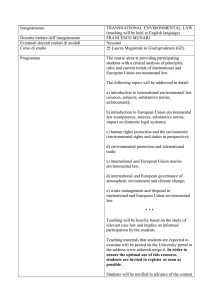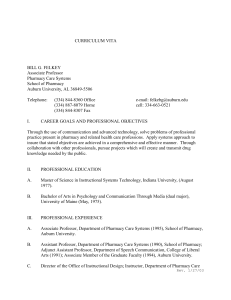Corso di Laurea in Farmacia: Requisiti Minimi e Criteri
advertisement
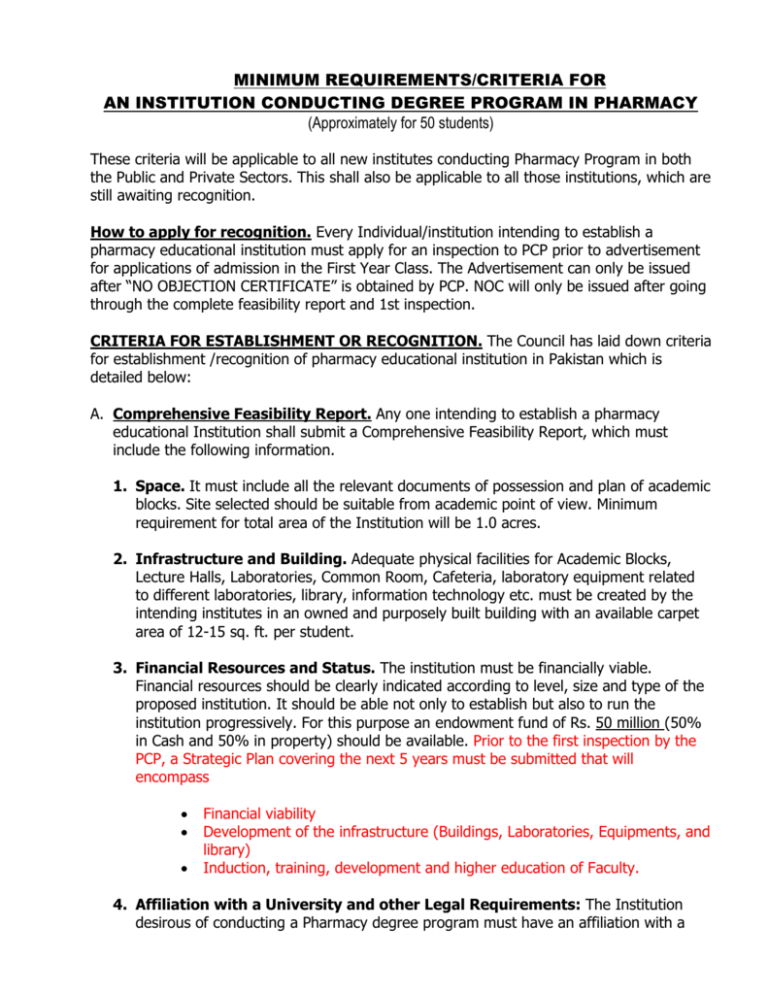
MINIMUM REQUIREMENTS/CRITERIA FOR AN INSTITUTION CONDUCTING DEGREE PROGRAM IN PHARMACY (Approximately for 50 students) These criteria will be applicable to all new institutes conducting Pharmacy Program in both the Public and Private Sectors. This shall also be applicable to all those institutions, which are still awaiting recognition. How to apply for recognition. Every Individual/institution intending to establish a pharmacy educational institution must apply for an inspection to PCP prior to advertisement for applications of admission in the First Year Class. The Advertisement can only be issued after “NO OBJECTION CERTIFICATE” is obtained by PCP. NOC will only be issued after going through the complete feasibility report and 1st inspection. CRITERIA FOR ESTABLISHMENT OR RECOGNITION. The Council has laid down criteria for establishment /recognition of pharmacy educational institution in Pakistan which is detailed below: A. Comprehensive Feasibility Report. Any one intending to establish a pharmacy educational Institution shall submit a Comprehensive Feasibility Report, which must include the following information. 1. Space. It must include all the relevant documents of possession and plan of academic blocks. Site selected should be suitable from academic point of view. Minimum requirement for total area of the Institution will be 1.0 acres. 2. Infrastructure and Building. Adequate physical facilities for Academic Blocks, Lecture Halls, Laboratories, Common Room, Cafeteria, laboratory equipment related to different laboratories, library, information technology etc. must be created by the intending institutes in an owned and purposely built building with an available carpet area of 12-15 sq. ft. per student. 3. Financial Resources and Status. The institution must be financially viable. Financial resources should be clearly indicated according to level, size and type of the proposed institution. It should be able not only to establish but also to run the institution progressively. For this purpose an endowment fund of Rs. 50 million (50% in Cash and 50% in property) should be available. Prior to the first inspection by the PCP, a Strategic Plan covering the next 5 years must be submitted that will encompass Financial viability Development of the infrastructure (Buildings, Laboratories, Equipments, and library) Induction, training, development and higher education of Faculty. 4. Affiliation with a University and other Legal Requirements: The Institution desirous of conducting a Pharmacy degree program must have an affiliation with a recognized University (established under a charter by the Federal or Provincial Government) of the same province, which has a Faculty of Pharmacy in their principle campus. The University granting affiliation to any institution conducting any Pharmacy Degree programs shall award degrees to the students of the affiliated institution only after their facilities have been evaluated and approved for conducting said program by the PCP. The Institute should fulfill all other legal formalities, details of which will be provided in due course. 5. Organizational Structure/Faculty: Faculty should be employed full time and as per regulations for appointment laid by the PCP. The Dean/Chairman/ Director/ Principal of the Faculty/Department/Institute or College/School of Pharmacy shall hold a basic degree in Pharmacy and must be eligible for appointment as Professor/ Associate Professor. CVs of every faculty member/all members of administration/staff should be provided for scrutiny, along with terms of reference for employment, qualifications, professional and teaching experience, date of joining, designation with details of research publications etc. etc. The Institutions offering a Degree program shall have the faculty strength as per following: Professor Associate Professor Assistant Professor Lecturers 10% 20% 30% 40% 6. Library: Library should be well equipped with sufficient number of books, latest editions of reference books/journals, computers with internet facilities and photocopying facility as per following: Books: At least 1500 with adequate coverage of all disciples and specialties of Pharmacy. Minimum of 3-5 copies of each recommended books should be available in the Library. Annual Addition of Books: 100 to 150 books. Periodicals: At least 5 including 3 international. 7. Attached Hospital. The attached hospital for imparting training in clinical pharmacy should be well equipped and functional. The hospital should have a minimum 100 beds for admission of 50 students. The hospital must be well reputed with all the major disciplines along with well equipped operation theatres and supportive services should be fully and freely available. B. SCRUTINY OF APPLICATIONS. The application for recognition must be submitted on a prescribed Performa, with details along with the fee prescribed for this purpose before undertaking the first inspection by the Council. The application will be scrutinized according to the laid down criteria. The Secretariat will ensure rectification of deficiencies or otherwise for approval by the Council or any relevant Committee for appointment of the Inspection Team. If approved, the inspection in question would be undertaken according to the following: i) All institutions, trying to get themselves established and wanted to advertise for admission of students in a pharmacy program, ought to be informed that they should submit applications for inspection before establishment of the institution. ii) In case they have failed to submit the application before the advertisement, then it should be mandatory that the newly established institution must apply to the Pharmacy Council of Pakistan to carry out the inspection before conducting the 1st year professional examination (this is only applicable to those colleges who had established before these criteria were published). iii) Depending upon the report submitted on initial scrutiny of the application, the Council or relevant Committee may arrive at the following decisions: The institution may be informed of the deficiencies detected on scrutiny, and asked to resubmit the request after removing the deficiencies for inspection. It is mandatory that revised application be submitted before conducting the first professional examination, failing which the PCP will bear no obligation to conduct inspection at later stages. The scrutiny team must ensure that the requirements laid down are duly approved by the Council and are available in the institution. The Pharmacy Council of Pakistan will have to scrutinize the applications within 6 months from the date of application. C. INSPECTION TEAM. The inspection team will be constituted by the Council comprising of members from academia and other disciplines of the profession. The Inspection team will be accompanied by the Secretary, PCP or one of its representative. D. INSPECTION SCHEDULE. Inspection of all relevant facilities should be conducted for concerned year of training at the times given below. The objectives for each visit are mentioned below and the details are present in the forms. VISIT 1: 1st comprehensive Inspection prior to first admission of the students for granting NOC. Objectives: The Inspection team will look into the following in addition to the criteria already given. Suitability of the venue for educational purposes. Availability of all necessary basic infrastructure and physical facilities needed during the first two professional years. Presence of needed basic educational resources. Recruitment of appropriate and adequate teaching faculty. Availability of written curriculum. Adequacy and sources of Funds. Procedure for financial accountability. Visit 2: At the time of first Professional Examination (semester/annual). Objectives: The Inspection team would observe Relevance of assessment to the objectives of training for the year. Presence of all required basic educational resources. Recruitment of appropriate and adequate teaching faculty. Availability of appropriate and adequate number of examiners. The Conduct of examination and Report on the transparency and fairness of the examination. Visit 3: Beginning of the 3rd year or third professional (5th semester) Objectives: The Inspection would look into. Availability of all necessary infrastructure and physical facilities needed during the second professional in the pharmacy institution. Presence of needed educational resources Recruitment of appropriate and adequate teaching faculty. Availability of written training program with objectives, syllabus, teaching methods and assessment program. Visit 4: At the time of final professional examination. Objectives: The Inspection Team would observe: Availability of all necessary infrastructure and physical and curricular facilities needed during the whole program The Conduct of examination. Adequacy of Clinical training opportunities and clinical faculty required for conducting the said training. Relevance of assessment to the objectives of training for the whole program in the Institution and the affiliated Hospital. In addition to the above, the Council can also conduct surprise inspections of the Institutions. The Pharmacy Programs of the Institutions which are recognized by the Council will be visited after every three years to ensure that the standards based on which institution was granted recognition, are maintained or not. LIST OF MINIMUM REQUIREMENTS OF PHYSICAL FACILITIES FOR A PHARMACY DEPARTMENT (approx for 50 students) I- BASIC REQUIREMENTS (HEC General Criteria for Establishment of Degree Awarding Institute) 2 lecture rooms 1 seminar room 1 library cum Reading room with Photocopier 1 committee room Teacher Students ratio 1:10 II- LECTURE THEATERS: Under Graduate(1st-5th Prof) No. 5 Capacity 50 students Dimension 600-750 sq feet each III-LABORATORIES 1- PHARMACEUTICS LABORATORY: Dimensional Requirement No. Under graduate Laboratory 1 Capacity Workshops (desirable) 50 students 1750-2250 sq feet each SUBJECTS REQUIRING SUCH FACILITY a. Pharmaceutical technology b. Physical pharmacy c. Bio-pharmaceutics d. Pharmaceutics e. Dispensing & Community Pharmacy f. Instrumentation & Quality Control 2- PHARMACOGNOSY LABORATORY: Dimensional Requirement No. Under graduate Laboratory 1 Capacity Workshops (desirable) 50 students 1750-2250 sq feet each SUBJECTS REQUIRING SUCH FACILITY a. Pharmacognosy- I b. Pharmacognosy- II 3- BASIC MEDICAL SCIENCES LABORATORY: Dimensional Requirement No. Under graduate Laboratory 1 Capacity Workshops (desirable) 50 students 1750-2250 sq feet each Animal room having capacity to accommodate large and small animals Anatomy museum SUBJECTS REQUIRING SUCH FACILITY a- Physiology b- Pharmacology c- Anatomy 4- PHARMACEUTICAL CHEMISTRY LABORATORY: Dimensional Requirement No. Capacity Workshops (desirable) Under graduate Laboratory 1 50 students 1750-2250 sq feet each SUBJECTS REQUIRING SUCH FACILITY a- Bio-chemistry Laboratory. b- Organic Chemistry Laboratory c- Medicinal Chemistry Laboratory 5- PHARMACEUTICAL MICROBIOLOGY LABORATORY: Dimensional Requirement No. Under graduate Laboratory 1 Capacity Workshops (desirable) 50 students 1750-2250 sq feet each SUBJECTS REQUIRING SUCH FACILITY a- Pharmaceutical Microbiology b- Pathology 6- INDUSTRIAL LABORATORY: Dimensional Requirement No. Under graduate Laboratory 1 Capacity Workshops (desirable) 50 students 1750-2250 sq feet each SUBJECTS REQUIRING SUCH FACILITY a- Industrial Pharmacy 7- INSTRUMENTATION & QUALITY CONTROL LABORATORY: Dimensional Requirement No. Under graduate Laboratory 1 Capacity Workshops (desirable) 50 students 1750-2250 sq feet each SUBJECTS REQUIRING SUCH FACILITY a- Instrumentation & quality control b- Pharmaceutical quality management 8- COMPUTER LABORATORY: Dimensional Requirement No. Under graduate Laboratory 1 Capacity Workshops (desirable) 50 students 1750-2250 sq feet each Minimum of 15 Computers ( 1 computer for each 3 students) Internet Source, Online Services, Access to HEC journals & E-library Minimum of 256 Kbytes access rate shall be provided SUBJECTS REQUIRING SUCH FACILITY a- Computer and its Applications in Pharmacy b- Online Drug Information Resources (Clinical Pharmacy) 9- AFFILIATED HOSPITAL FACILITY: Minimum of 250 Bed With well established Medical departments Established Hospital Pharmacy Services Full time Pharmacists proportionate to bed strength (i.e. one pharmacist for 50 beds. Full time Staffed Professor of Medicine as Clinical Training Coordinator SUBJECTS REQUIRING SUCH FACILITY a- Clinical Pharmacy-I b- Clinical Pharmacy-II LIST OF MINIMUM REQUIREMENTS FOR HOSPITAL FOR IMPARTING TRAINING IN CLINICAL PHARMACY (Approximately for 50 students) I- BASIC REQUIREMENTS: a) Dimensional Requirement: Minimum of 100 Beds b) Services: Central Pharmacy Satellite Pharmacies at departmental level Dispensing & Compounding Services Pharmacy & Therapeutic Committee Essential Drug List & Formulary Management Services. c) Facilities: Adjoining Class rooms/ Patient Presentation sites in each ward with a minimum capacity for accommodating 25 students. Sufficient Library/ Professional Information access. White Board, fixtures & other teaching aids. d) Departments: Emergency Department Medicine/ Medical Pediatric Care Unit Cardiology Ear, Nose, Throat (ENT) Dermatology Neurology Ward Surgical Unit. II- REQUIREMENTS FOR TECHNICAL & PROFESSIONAL STAFF a) b) NOTE: Numbers One Consultant in each ward One Registrar at least in each ward One Pharmacist at least in each ward. Qualification Head of Department & Incharges Registrar/ Post Graduate Registrar Pharmacist (F.C.P.S.) (MBBS with Part-1 ) (B. Pharmacy / Doctor of Pharmacy ) The above mentioned facilities may be relaxed in the areas where teaching hospitals are not available. III- MODE OF IMPARTING TRAINING: Attend students in each respective wards Maintaining Discipline and their attendance. Conducting lectures/ illustrations/ presentations of Syllabus concerned. Presenting patients with different clinical situations Discuss pathological and pharmacotherapy with medical prescriber, Pharmacist and students 10 short cases in the 4th Prof. (7th & 8th semester). 10 long cases in the 5th Prof. (9th & 10th semester). IV- FACULTY REQUIREMENT All the academic staff will hold basic degree in Pharmacy except in the subjects of Pathology, Physiology/Histology, Anatomy, Computer Science, Islamic Studies, Pakistan Studies, Social Studies, Management Studies, English, and Mathematics . In these subjects the teachers may be employed as visiting faculty. The Dean/Director/Principal/Chairman shall hold a basic degree in Pharmacy and will be eligible for appointment as Professor or at least Associate Professor. The Experience of the Teaching Faculty at the time of appointment No more than 10% of the Teaching Faculty will be Pharmacy Graduates with less than 3 Years of teaching experience in the relevant subject or 5 Years of experience in Pharmacy Practice/Pharma Industry/Drug Regulation. No less than 10% of the Teaching Faculty will be permanent and holding PhDs in the relevant subject V-COMMON REQUIREMENTS Auditorium having a capacity of 500 students Computer laboratory having a capacity of 50 students (60*30 feet) Conference room (teachers) having capacity of 50 seats (60*35 feet) Centralized research laboratory consisting of 3 rooms each of measurement (80*35 feet) Girls common room (as per HEC criteria) Boys common room (as per HEC criteria) Library (140*70 feet) Staff room (50*30 feet) Prayer room (60*60 feet) Stores Required a) Main store (50*30 feet) b) Chemical store (60*40 feet) c) Glass ware store (60*40 feet) d) Common store (100*60 feet) Washrooms for a) Male and female Teachers b) Boys and girls. VI- OFFICES / ADMINISTRATION REQUIREMENT OFFICES No. Chairman office Clerical offices 1 1 Staff room Faculty office for each depart: Professors Associate professors Assistant professors 1 1 1 1 2 Lecturers 2 LIST OF MINIMUM REQUIREMENTS OF EQUIPMENTS IN GRADUATE LABORATORIES OF PHARMACY DEPARTMENT (approximately for 50 students) A- Graduate Laboratory. i) Bio-chemistry Laboratory. ii) Organic Chemistry Laboratory iii) Medicinal Chemistry Laboratory iv) Pharmaceutics Laboratory v) Dispensing & Compounding Laboratory vi) Instrumentation Laboratory vii) Pharmacology Laboratory viii) Physiology Laboratory ix) Pharmaceutical Microbiology Laboratory x) Industrial Pharmacy Laboratory xi) Pharmacognosy Laboratory A- Graduate Laboratory 1-Bio-chemistry / Organic / Inorganic Laboratory (approx for 50 students) S. No. Name of Instruments Quantity 1 Water bath single hole 10 2 Triple beam balance 5 3 Microscope 15 4 Water bath 10 5 Balance digital balance 2 6 Melting Point Apparatus 10 7 Spectrophotometer 2 2- Pharmaceutics / Dispensing Laboratory (approx for 50 students) 1 Triple beam balance 5 2 Water bath 10 3 Cold & Hot Incubator 1 3- Pharmacology/ Physiology Laboratory (approx for 50 students) 1 2 3 4 5 6 7 8 9 10 11 12 13 14 15 16 17 18 19 20 21 22 23 24 25 Haemometer set Tissue organ bath Kymograph Triple beam balance Digital balance Microscope Oven Burner Barometer E.S.R stand Spiro meter plastic body Western Green Tubes Glass Test Tubes Test Tub stands Neubar Chamber 0.0025mm2 RBC Pipette WBC Pipette Snellen’s Chart(Eye) Meter rod Sphygmomanometer Stethoscope Sahli’s haemometer Wet Spiro meter Perimeter With Object ECG machine 8 15 15 5 2 15 1 15 5 15 5 15 100 20 10 10 15 10 10 15 15 10 5 10 1 26 27 28 29 Wattmann Filter paper Antiserum A B & D Histology Slides Weight Machine 10 pack 5 Complete sets All Basic 2 4- Microbiology Laboratory (approx for 50 students) 1 2 3 4 5 6 7 8 8 Autoclave Cool incubator Hot incubator Laminar air flow Horizontal Laminar air flow Vertical Oven Microscopes Compound Reciprocating Shaker Deep freezer 2 1 1 1 1 2 15 1 1 5-Pharmacognosy Laboratory (approx for 50 students) 1 2 3 4 5 6 7 Centrifuge machine Microscope Microtome Oven Water bath 4 holes Rota Evaporator + Chiller Aspirator 2 15 1 2 6 3+1 1 6- Industrial Laboratory (approx for 50 students) 1 2 3 4 5 6 7 8 9 10 11 12 13 14 15 16 17 Powder Filling Machine Single Punch Tablet Machine Coating Pressure Tank Sigma Blade Mixer Friability Test Apparatus Dissolution Apparatus Dissolution Apparatus (6) Basket Disintegration Apparatus Single Vessel Disintegration Double vessel Syrup Filling Machine Colloidal Mill Capsule Filling Machine Silverson Mixer Ampoule gasses Oven Ointment Filling Machine Mechanical Stirrer 1 1 1 1 1 1 1 1 1 1 1 1 1 1 1 1 1 18 19 20 21 22 23 24 25 26 27 28 29 30 31 32 33 34 35 36 Rotary Press Wet Granulator Dry Granulator Disintegrator Automatic Ampoule filling machine Tray dryer Digital weight balance Furnace Ball Mill Mechanical Stirrer Filter Press Water Deionizer Plant Disintegration single vessel Tablet coating conventional pans Canvas line pan Single blade mixer Distillation apparatus (Gas) Centrifuge Vernier Caliper Screw capping & Sealing machine 7-Instrument Room. (approx for 50 students) 1 UV Spectrophotometer Double Beam 2 IR Spectrophotometer 3 Flame photometer 4 Digital Dissolution Apparatus & Auto sampler 5 Polari meter 6 Digital Incubator 7 Digital Moisture analyzer 8 Digital hardness tester 9 Kenwood Planetary Mixer 10 UV Spectrophotometer Single Beam 11 Magnetic Stirrer+ Hot Plate 12 Digital Weight balance 13 Magnetic stirrer 14 Vortex Mixer 15 pH Meter 16 Centrifuge Machine 17 Stability chamber 18 Oven 19 Deep Freezer 20 Refrigerator 21 Incubator 22 Water Distillation Unit 23 Water deionizer 1 1 1 1 1 1 1 1 1 1 1 1 2 1 1 1 1 1 1 1 1 1 1 1 1 1 1 1 1 1 1 1 1 1 1 1 1 1 1 1 1 1 10- Library: 35* 60 feet (approx for 50 students) Subject-wise books requirement: . SUBJECT Copies SUBJECT Analytical Chemistry 10 each Anatomy Biochemistry 10 each Bio Pharmaceutics Clinical Pharmacy 10 each Compendia’s Dictionary 1 each Dispensing Drug Law 10 each Forensic Hospital Pharmacy 10 each Industrial pharmacy Pharmaceutical Chemistry 10 each Math Management 10 each Medicinal chemistry Microbiology 10 each Organic chemistry Pharmaceutics 10 each Pharmacognosy Pharmacology 10 each Physical Pharmacy Physiology 10 each Quality Control Statistics 5 each Professional Magazines & Writings: Quantity Sufficient Research Journals: Quantity Sufficient 17) Students and teacher ratio 1:10 (as per HEC Criteria) Copies 10 each 10 each 1 each 10 each 10 each 10 each 5 each 10 each 10 each 10 each 10 each 10 each MINIMUM REQUIREMENTS OF CHEMICALS FOR UNDER-GRADUATE LABORATORIES (Approximately for 50 students) S. No. 1. 2. 3. 4. 5. 6. 7. 8. 9. 10. 11. 12. 13. 14. 15. 16. 17. 18. 19. 20. 21. 22. 23. 24. 25. 26. 27. 28. 29. 30. 31. 32. 33. 34. 35. 36. 37. 38. 39. Chemicals Ammonia Ammonium chloride Acetic acid Acetyl salicylic acid Acetone Atropine sulphate Anise oil Aniline Acetanilide Aluminium chloride Acetyl chloride Acriflavine Acetamide 4-amino phenol Acetophenone Aspartic acid 4-amino benzoic acid 2-acetyl salicylic acid Amm. Bicarbonate Ammonium molybedate Amaranth Accacia gum Acid fuchsin ind. Anthrone Arabinose Adipic acid Aluminium hydroxide Ascorbic acid Arginine Albumin(bovine) Anthraciene Acetyl choline Aspirin power Alanine Aluminium sulphate Amyl alcohol Amm iron II sulphate Asparagines Almond bitter oil Minimum Quantity In hand (approx for 50 students 20 L 2 Kg 25 L 3 Kg 15 L 25 gm 1 Lb 5L 1 Kg 1 Kg 1L 1 Pack 1 Kg 250 gm 1L 100 gm 250 gm 1 kg 2 kg 1 kg 2 kg 10 Kg 250 ml 50 gm 10 gm 1Kg 1 Kg 1 Kg 100 gm 500 gm 250 gm 25 gm 2 Kg 50 Gm 1 gm 1L 1Kg 25 gm 2L 40. 41. 42. 43. 44. 45. 46. 47. 48. 49. 50. 51. 52. 53. 54. 55. 56. 57. 58. 59. 60. 61. 62. 63. 64. 65. 66. 67. 68. 69. 70. 71. 72. 73. 74. 75. 76. 77. 78. 79. 80. 81. 82. 83. 84. Adernaline voil Alizarine red Amm.sulphate Arachis oil Amm oxalate Agarose Acrylamide Acetonitril Aluminium oxide Adenosine tri phosphate Calcium carbonate Copper sulphate Citric acid Carbon tetra chloride Chloroform Cupric sulphate Cupric acetate Cinamic acid Coumarin Cupric oxide Chloro acetic acid Caffeine Calcium lactate Crystal violet Chloral hydrate Charcoal animal Camphor Calcium chloride Creatinine Cetomacrogol Coriander oil Cod liver oil Calamine Ceric amm sulphate Chloramines Cyclo hexane Cystine Clove oil Carmine Cedar Woood Oil Cinnamon oil Caster oil Cardamom oil Caraway oil Calcium hydroxide 25 ml 25 gm 1 kg 1L 1 kg 10 g 1 kg 2.5 L 1 Kg 100 gm 1 kg 2 kg 1 kg 10 L 10 L 1 Kg 1 Kg 1 kg 1 kg 1 kg 1 kg 1 Lbs 2 Kg 100 gm 2 Kg 1 Kg 2 Kg 2 Kg 25 gm 1 kg 1L 1L 2 Kg 25 gm 1L 5L 25 gm 1 Lbs 1 Lbs 1L 1L 5L 1L 1L 2 Kg 85. 86. 87. 88. 89. 90. 91. 92. 93. 94. 95. 96. 97. 98. 99. 100. 101. 102. 103. 104. 105. 106. 107. 108. 109. 110. 111. 112. 113. 114. 115. 116. 117. 118. 119. 120. 121. 122. 123. 124. 125. 126. 127. 128. 129. Canada balsam Calcium acetate Cetyl alcohol Cobalt chloride Cobalt nitrate Congo red Cresol red solution Cellulose Cadmium chloride Chloro benzene Carbapol Calcium phosphate Calcium sulphate Calcium stearate Carboxy methyl cellulose Cellulose acetate phthalate Carnauba black wax Calcium oxide Capillary tube Celite powder Coconut oil Carbal fuchine Di pot.hydrogen phosphate Di methyl aniline Di phenylamine Di oxane Di methyl formamide Di sod phosphotungstate Di sod tartarate 2-6-dichloro phenol indophenol Dextrose powder Di ethylamine Di sod di hydrogen phosphate Dextrine Dextrine blue Di methyl sulphoxide Di chloro methane Di phenyl carbazide Diclofenac sodium Di pot di hydrogen phosphate Ethyl acetate Ethanol Erichrome black Ethylene diamine tetra acetic acid Ether solvent 1L 1 Kg 2 Kg 500 gm 500 gm 50 gm 50 gm 1 kg 250 gm 2.5 L 1 Kg 1 kg 1 kg 1 kg 2 kg 1 kg 1 kg 1 kg 10 Packet 1 kg 1 kg 500 ml 2 kg 1L 1 kg 2.5 L 2.5 L 250 gm 1 kg 25 gm 1 kg 1L 5 kg 1 kg 100 gm 2L 5L 20 gm 500 gm 2 kg 5L 20 L 25 gm 1 kg 5L 130. 131. 132. 133. 134. 135. 136. 137. 138. 139. 140. 141. 142. 143. 144. 145. 146. 147. 148. 149. 150. 151. 152. 153. 154. 155. 156. 157. 158. 159. 160. 161. 162. 163. 164. 165. 166. 167. 168. 169. 170. 171. 172. 173. 174. Eosine(stain) Ethylene glycol Ethylene diamine Ethyl cellulose Eudragit-L-100 Emyluesifing wax Glucose Glactose Glycine Glutaric acid Gallic acid Glycerine Gum Arabic Gelatin Glutamic acid Gram’s staining Giemsa stain Glutamine Glass wool Glass slide Glass cover slip Hydrogen per oxide Hydro chloric acid Hydroquinone Hydroxylamine hydro chloride Heavy kaoline Hydroxyl praline Histidine 8-hydroxy quinoline Hydroxyl ethylene cellulose Hydroxy propyl methyl cellulose Hydroxyl ethyl cellulose 4-hydroxy benzoic acid Iodine Idoform Isatin Kiesulgahr Litmus paper blue Litmusb paper red Litmus blue powder Lemon oil Lactose Lead acetate Lenoline Leishman stain 25 gm 1L 1L 1 kg 1 Kg 1 kg 10 kg 1 kg 500 gm 500 gm 500 gm 10 L 1 Kg 1 kg 500 gm 500 gm 500 ml 500 ml 2 kg 50 packs 50 packs 1L 10 L 1 kg 1 kg 5 kg 25 gm 25 gm 50 gm 1 kg 500 gm 500 gm 100 gm 1 kg 1 kg 2 kg 10 pack 10 pack 25 gm 25 gm IL 5 kg 1 kg 1 kg 500 ml 175. 176. 177. 178. 179. 180. 181. 182. 183. 184. 185. 186. 187. 188. 189. 190. 191. 192. 193. 194. 195. 196. 197. 198. 199. 200. 201. 202. 203. 204. 205. 206. 207. 208. 209. 210. 211. 212. 213. 214. 215. 216. 217. 218. 219. Light green Light magnesium carbonate light magnesium oxide Light kaoline Leucine Methyl red Methyl orange Magnesium sulphate Malic acid Malonic acid Maleic acid Methanol Maltose Malachite green Mercuric acetate Methyl blue Methyl cellulose(20) Methyl hydroxyl benzoate Mercuric chloride Magnesium chloride Methyl salicylate Magnesium tri salicate Methyl acetate Macconkey agar Mannitol Methionine Menthol Magnesium stearate powder Mineral oil Micro crystalline cellulose Methyl paraben Magnesium carbonate Mustard oil Magnesium oxide N-butanol n-hexane Nitric acid 2-nitro phenol 4-nitro phenol 1-naphthol 2-naphthol 1-napthyle amine Ninhydrin Nutmeg oil Nitro benzene 100 gm 5 kg 3 kg 5 kg 25 gm 25 gm 25 gm 1 kg 1 kg 500 gm 1 kg 10 L 1 kg 25 gm 250 gm 25 gm 10 kg 1 kg 500 gm 1 kg 5L 1 kg 1L 500 gm 500 gm 25 gm 500 gm 2 kg 3L 1 kg 500 gm 2 kg 1L 500 gm 5L 5L 10L 25 gm 25 gm 1 kg 1 kg 1 kg 50 gm 1L 2.5 L 220. 221. 222. 223. 224. 225. 226. 227. 228. 229. 230. 231. 232. 233. 234. 235. 236. 237. 238. 239. 240. 241. 242. 243. 244. 245. 246. 247. 248. 249. 250. 251. 252. 253. 254. 255. 256. 257. 258. 259. 260. 261. 262. 263. 264. Nutrient broth Nickel chloride Naphthalene Nutrient agar Orange oil Oleic oil Oxalic acid Orcinol Olive oil Pot.di hydrogen phosphate Pot.dichromate Pot.permaganate Pyridine Phenol red Phenolphthalein Paraffin oil Pot. Iodide Phenyl hydrazine hydro chloride Pot. hydrogen phosphate Pot. Meta bi sulphate Pthalic anhydride Pyrocatechol Phenol Pot.Hydride Pyrogallol Phloroglucinol Pot.chromate Phenyl urea Pot.Thyiocyanate Phthalimide Pot.sod.tartrate. Phenacetine Pot.hydrogen phthalate Picric acid Petroleum ether Pot.chloride Paraffin soft Paraffin hard Per chloric acid Phosphotungstic acid Petroleum jelly Propylene glycol Poly sorbate Proline O-phosphoric acid 500 gm 250 gm 500 gm 500 gm 1L 2L 2 kg 25 gm 2L 5 kg 1 kg 1 kg 2L 25 gm 500 gm 20 L 1 kg 500 gm: 1 kg 250 gm 500 gm 1 kg 1 kg 3 kg 1 kg 100 gm 1 kg 25 gm 1 kg 1 kg 2 kg 100 gm 500 gm 500 gm 2.5 L 3 kg 5 kg 5 kg 1L 250 gm 5 kg 5L 500 mg 25 gm 2.5 L 265. 266. 267. 268. 269. 270. 271. 272. 273. 274. 275. 276. 277. 278. 279. 280. 281. 282. 283. 284. 285. 286. 287. 288. 289. 290. 291. 292. 293. 294. 295. 296. 297. 298. 299. 300. 301. 302. 303. 304. 305. 306. 307. 308. 309. Pot.citrate Petroleum ether Pot.bromide Palmitic acid 2-propanol Poly ethylene glycol(400) Poly ethylene glycol(4000) Poly ethylene glycol(8000) Poly ethylene glycol(200) Pot.carbonate Pot.ferrocyanide Pot.nitrate Pot.sulphate Poly vinyl alcohol Poly ethylene Poly vinyl chloride Poly vinyl pyrolidone p.v.p crosslinked Povidon Pot.floride Peppermint Paracetamol Propyl paraben Resorcinol Rose oil Raspberry. Sod. Carbonate Sod.hydroxide Sod.bi carbonate Salicylic acid Starch Sod.acetate Sucrose Sod.thio sulphate Sulphanilic acid Sod nitropruside Succinic acid Succinamide Sod.hydrogen sulphate Silica gel Salicyladehyde Sod. Sulphate Sod.benzoate Sod.metal Sod. Nitrite 500 gm 5L 500 gm 1 kg 10 L 1L 1 kg 1 kg 1L 2 kg 500 gm 500 gm 500 gm 1 kg 1 kg 1 kg 1 kg 1 kg 1 kg 500 gm 2L 1 kg 500 gm 25 gm 1L 1L 5 kg 5 kg 3 kg 2 kg 2 kg 1 kg 1 kg 1 kg 500 gm 250 gm 1 kg 500 gm 500 gm 2 kg 500 gm 2 kg 500 gm 1 kg 500 gm 310. 311. 312. 313. 314. 315. 316. 317. 318. 319. 320. 321. 322. 323. 324. 325. 326. 327. 328. 329. 330. 331. 332. 333. 334. 335. 336. 337. 338. 339. 340. 341. 342. 343. 344. 345. 346. 347. 348. 349. 350. 351. 352. 353. 354. Silver nitrate Sod. Nitrate Saffranine Borax Sulphuric acid Sod.citrate Sublimed sulphur Sod.chloride Saccharine Sorbitol Sod. Molybdate Silica gel moisture Sod.acid phosphate Sod. Sulphite Stearic acid Sod.di hydrogen phosphate Sod.lauryl sulphate Sod.salicylate Sun flower oil Sod bromide Sulphanilamide Sod tungstate Sod carboxy methyl cellulose Sod floride Tartaric acid Thio urea Toluene Thymol Turpentine oil Tannic acid Tincture of benzoin Tragacanth Triethylamine Tri chloro acetic acid Tryptophan Tyroscine Tri. Sod. Citrate Tincture cardamom Titanium di oxide Talcum Thymol blue Tween-80 Triethanolamine Tin granular Universal ph paper 25 gm 500 gm 25 gm 1 kg 10 L 500 gm 500 gm 5 kg 1 kg 500 ml 500 gm 1 kg 500 gm 500 gm 2 kg 1 kg 5 kg 3 kg 1L 500 gm 250 gm 250 gm 2 kg 500 gm 4 kg 2 kg 5L 100 gm 5L 1 kg 500 ml 1 kg 1L 250 gm 25 gm 25 gm 500 gm 500 ml 500 gm 5 kg 25 gm 1L 1L 200 gm 10 packs 355. 356. 357. 358. 359. 360. 361. 362. 363. 364. 365. 366. 367. 368. 369. 370. 371. 372. 373. 374. 375. 376. 377. 378. 379. Urea Vaniline Valine Whatman filter paper Wool fat Wool alcohol Xylose Xylene (xylol) Zinc sulphate Zinc powder Zinc chloride Zinc oxide Zn staining Zein Zinc metal (granulated) Boric acid Benzene Bromine Benzil Benzamide Biphenyl Benzaldehyde Benzoyl chloride Beeswax Benzyl chloride 1 kg 25 gm 25 gm 5 packs 2 kg 2 kg 25 gm 2.5 L 1 kg 1 kg 500 gm 500 gm 500 ml 100 gm 500 gm 1 kg 5L 1L 500 gm 500 gm 1 kg 500 gm 1L 1 kg 1L MINIMUM REQUIREMENTS OF GLASSWARE FOR UNDER-GRADUATE LABORATORIES (Approximately for 50 students) S. No. 1. 2. 3. 4. 5. 6. 7. 8. 9. 10. 11. 12. 13. 14. 15. 16. 17. 18. 19. 20. 21. 22. 23. 24. 25. 26. 27. 28. 29. 30. 31. 32. 33. 34. 35. 36. 37. 38. Items 3-neck R. B. flask (100 & 250 ml) Air condenser Air steam inlet tube Buchner filter funnel Buchner funnel Burettes Borosilicate glass China crucible China dish Condenser Cone MF 15/2 Cone MF 15/1 Conical Flask Flat Bottom (Various Capacities) Desiccator Desiccator plates Drying tube bent ESR westergren tube Filter flask Funnels Gas washing bottle Glass cover slip Glass slide plain Gloves Graduated Cylinder (Various capacities) Graduated pipette Graduated pipettes, Pyrex (Various capacities) Hollow stopper Iron stand clamp Liebig condenser Magnetic stirrer bar Markham still Melting point apparatus Micro Pipettes Adjustable Multiple adapter Pestle & mortar Petri dish Pycnometer Pipette filter R.B.C pipette Minimum Quantity Required (approx for 50 students 30 20 50 20 10 15 15 30 20 20 20 50 10 15 15 15 15 30 30 10 pack 10 pack 50 50 30 30 15 30 15 10 15 15 15 15 15 50 30 30 30 39. 40. 41. 42. 43. 44. 45. 46. 47. 48. 49. 50. 51. 52. 53. 54. 55. 56. 57. 58. 59. 60. 61. 62. 63. 64. 65. 66. 67. 68. 69. 70. 71. 72. 73. 74. 75. 76. 77. 78. R. B. flask R. flask Reagent bottle Receiver adopter Receiver bend with vent Receiving flask Round Bottom Flask (Various capacities) Socket Soxhlet apparatus Spatula Spatula small steel Stop cork assembly Syringe disposable Test Tube 1/ 1000 Volumetric Flasks Glass (Various capacities) W.B.C. pipette Water taps Capillary tube Fusion tube Test tube (5 ml & 25 ml) Funnel plane angle (60 mm & 80 mm) Thermometer (100 C/ 110 C, 360C &340C) Water distillation plants (Electric) Beaker (50, 100, 250,1000 &2000 ml) Separating funnel (100 ml & 250 ml) Funnel plain (100 ml) Measuring flask (50,100,250,500 &1000ml) Volumetric pipette (10 & 20 ml) Titration flask (50,100 &250 ml) Burette (10 & 50 ml) Measuring cylinder (10,50,100 &250 ml) Condenser (14/23,19/26 & 24/29) Round bottom flask (50,100 &1000 ml) 3-neck round bottom flask (100 & 250 ml) Receiving flask (50,100 & 250 ml) Desiccator (140,200 mm, 150 ml) Desiccator plate Pycnometer (10,25 & 50 ml) Glass washing bottles (250 ml) Cone MF 15/1 and 15/2 (14/23, 19/26) 30 30 100 30 30 20 30 20 15 20 20 20 10 pack 10 Pack 10 each 20 20 10 pack 10 10 pack each 20 10 each 2 minimum 20 each 10 each 10 each 10 each 10 each 10 each 10 each 15 each 10 each 10 each 10 each 10 each 5 each 10 10 each 15 each 15 each 79. 80. 81. 82. 83. 84. 85. 86. 87. 88. 89. 90. 91. 92. 93. 94. 95. 96. 97. 98. 99. Dropping bottle (125 ml) Viscometer Watch glass (2 inch & 3 inch) Glass slide plain Glass cover slip Petri dish (4 inch) Iodine flask (250 ml) Neubauer’s chamber Air condenser (C2/11,C2/12) Glass tile Safety glasses Flat bottom flask (5 L) Rotational viscometer Micro pipette Wall thermometer Depression slide Colony counter Filtration assembly Distillation apparatus glass Glass vials Lens for microscope (10X & 40X) Note. All the Glass apparatus will be of Class A grade 15 each 15 20 each 10 Pack 10 Pack 20 20 20 20 20 20 10 10 20 2 20 1 5 5 50 5
